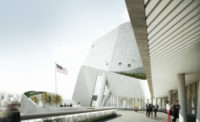Le Corbusier and New York City: A Love-Hate Relationship

The relationship between Le Corbusier and New York City involved love and hatred, passion and resentment, and ultimately a quest by the architect for “revenge, recognition, and money, money, money,” according to Jean-Louis Cohen, the architecture historian who curated the new show at New York's Museum of Modern Art, Le Corbusier: An Atlas of Modern Landscapes (June 15 through September 23). To mark the opening of the MoMA show, Cohen and others spent a day discussing the architect’s tortured affair with the city, during a symposium called “Le Corbusier/New York” at the Center for Architecture.
Even before his first trip to New York, Le Corbusier described Manhattan as “utterly devoid of harmony” and “a storm, a tornado, a cataclysm,” according to Mardges Bacon, a professor at Northeastern University. When he arrived in Manhattan for the first time, in 1935, he held a press conference at which he described even the Empire State Building as too small and claimed the city’s leaders were too timid to hire him. He later described the height of Manhattan’s towers as “nothing more than the manifestation of an inferiority complex.” He also wrote an opinion piece in the New York Times in which he claimed that “American skyscrapers have not attained the rank of architecture; rather, they are merely small objects such as statuettes or knick-knacks, magnified to titanic proportions.” In their stead, he proposed a city of buildings that “don’t try to outdo each other but are all identical,” with highways running right to their front doors—he believed the city’s grid system was obsolete in the automobile age. Le Corbusier met with many of the city’s power brokers, including Nelson Rockefeller, who was then running his family’s real estate business. Le Corbusier pitched an early version of his Unite d’Habitation, but after two months with no commissions, he returned to France, dazzled and disappointed.
In perhaps the most surprising presentation of the day, Cohen documented the troubled relationship between Le Corbusier and MoMA, which included physical destruction of some models during shipping to the museum, mistrust (for more than a decade, Le Corbusier claimed not to have received a payment from MoMA for a model he had pressed the museum to acquire), and under-appreciation (the museum squeezed its 1935 exhibition of the architect’s work into just 180 square feet). During the protracted negotiation over a planned show in the 1950s, Le Corbusier was determined that the museum would not make him “a sucker a second time,” said Cohen. The show was eventually canceled. Meanwhile, MoMA was lavishing attention on his rival Mies van der Rohe, a favorite of Philip Johnson, who founded MoMA’s department of architecture.
Columbia University professor Mary McLeod described Le Corbusier’s equally complicated relationship with that institution, which culminated in his receiving an honorary degree in 1961 after lengthy negotiations in which Corbu portrayed himself simultaneously as a person of simple needs and as “an underappreciated, misunderstood great man.” Fittingly, McLeod said, it was raining on the day he received his degree, and when he left the university’s Low Library, he unrolled his honorary doctorate and used it as a rain hat.
The symposium ended with a tour of the United Nations, acknowledging Le Corbusier’s role in the design of the complex (which was eventually executed by other firms), an episode, Cohen said, which made him feel “his baby had been taken from him.” It was one of many slights inflicted on him by the city.


